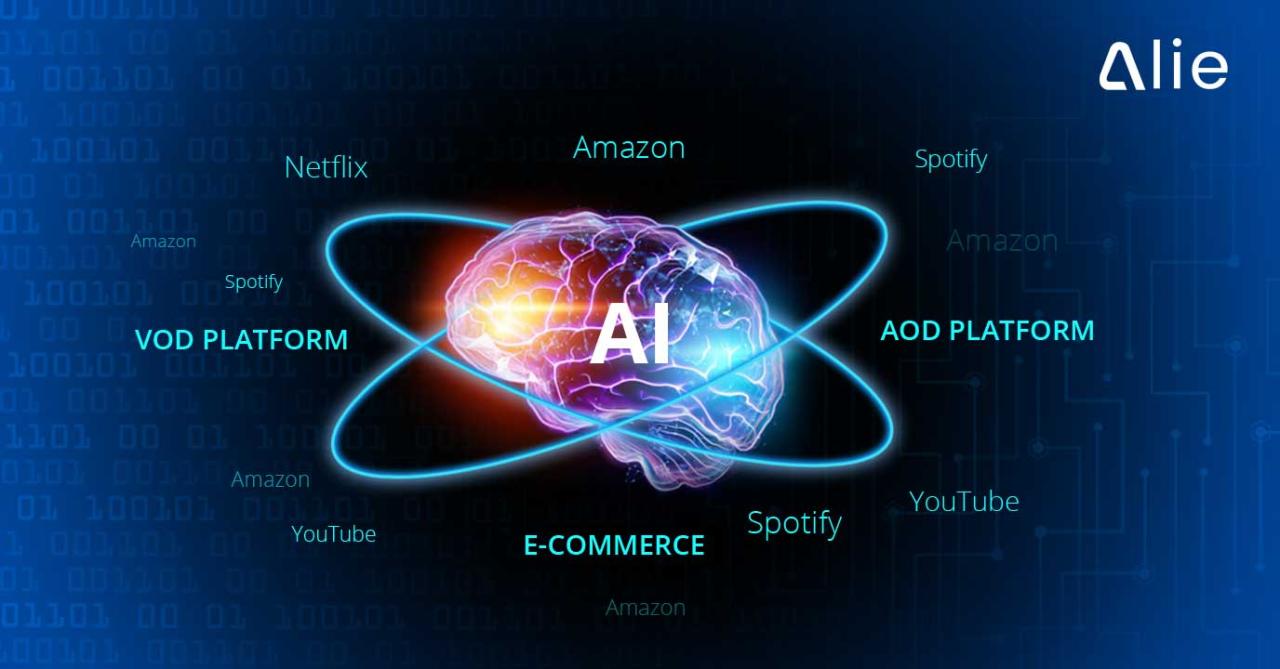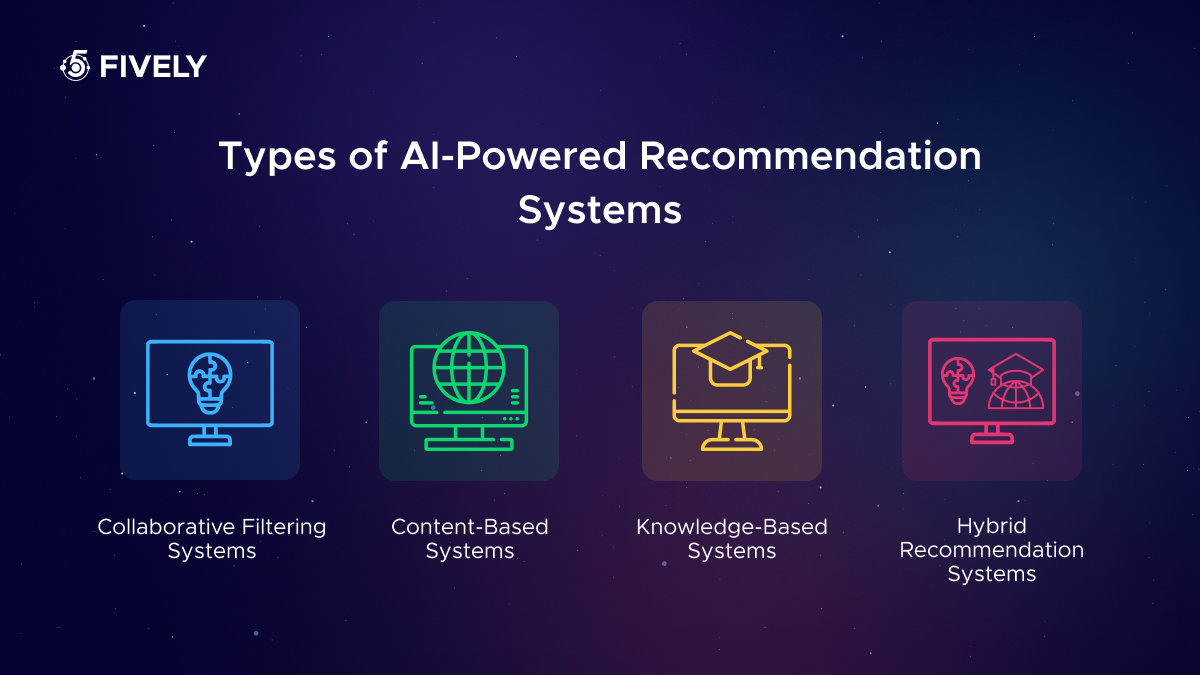AI-based recommendation engines are transforming how businesses interact with their customers. These sophisticated systems leverage the power of artificial intelligence to analyze user data and predict preferences, offering personalized recommendations that enhance user experience and drive engagement. From suggesting products on e-commerce sites to curating personalized playlists on streaming services, these engines are ubiquitous in the digital landscape.
This exploration delves into the underlying algorithms, data handling techniques, and evaluation metrics that shape these powerful tools.
Understanding the different types of recommendation engines—content-based, collaborative filtering, and hybrid approaches—is crucial. Each approach presents unique strengths and limitations, influencing the effectiveness of the system. This overview will explore these distinctions, highlighting the complexities and nuances involved in designing and implementing effective AI-based recommendation systems. Furthermore, we will address the ethical considerations and future trends shaping this rapidly evolving field.
Introduction to AI-Based Recommendation Engines

AI-based recommendation engines are sophisticated systems that leverage artificial intelligence techniques to predict and suggest items users might be interested in. These systems analyze vast amounts of data to personalize the user experience across various platforms, from e-commerce websites to streaming services. They go beyond simple rule-based systems by adapting and learning from user interactions, leading to more accurate and relevant recommendations over time.AI-based recommendation engines are becoming increasingly prevalent in various industries due to their ability to enhance user engagement and drive sales.
They play a crucial role in filtering information overload and surfacing personalized content that aligns with individual preferences.
Types of AI-Based Recommendation Engines
Several approaches exist for building AI-based recommendation engines, each with its strengths and weaknesses. Understanding these differences is key to selecting the most appropriate method for a given application.
- Content-Based Filtering: This approach recommends items similar to those a user has previously liked or interacted with. The system analyzes the features of items (e.g., genre for movies, s for articles) and identifies items with similar characteristics. For example, if a user enjoys action movies, the system will recommend other action movies.
- Collaborative Filtering: This method leverages the preferences of other users with similar tastes. It identifies users with similar rating patterns and recommends items that those similar users have enjoyed. For instance, if users who liked a particular book also liked another, the system will recommend the second book to the initial user.
- Hybrid Approaches: These combine content-based and collaborative filtering techniques to leverage the strengths of both. A hybrid system might initially use content-based filtering to generate a list of potential recommendations, then refine that list using collaborative filtering to prioritize items preferred by similar users. This often yields more accurate and diverse recommendations.
Benefits and Limitations of AI for Recommendations
Employing AI for recommendations offers significant advantages, but also presents certain challenges.
- Benefits: Increased personalization leading to higher user engagement and satisfaction, improved conversion rates and sales, efficient information filtering, and the ability to discover new and relevant items users might not have found otherwise.
- Limitations: Potential for filter bubbles and echo chambers, reliance on large datasets for effective training, cold-start problems (difficulty recommending items to new users or for new items with limited data), and the ethical considerations surrounding data privacy and bias in algorithms.
Comparison of Recommendation Engine Approaches
The following table summarizes the key characteristics of different recommendation engine approaches:
| Approach | Description | Strengths | Weaknesses |
|---|---|---|---|
| Content-Based Filtering | Recommends items similar to those a user has liked. | Simple to implement, no need for user data beyond individual preferences. | Limited ability to discover new items outside user’s existing preferences; susceptible to overspecialization. |
| Collaborative Filtering | Recommends items liked by users with similar preferences. | Can discover new items outside a user’s existing preferences. | Requires large amounts of user data; suffers from the cold-start problem. |
| Hybrid Approaches | Combines content-based and collaborative filtering. | Combines strengths of both approaches, mitigating weaknesses. | More complex to implement. |
Algorithms and Techniques

Recommendation engines rely on sophisticated algorithms to analyze user data and predict preferences. Understanding these algorithms is crucial to grasping the power and limitations of these systems. This section will explore several key techniques, highlighting their strengths and weaknesses.
Collaborative Filtering Algorithms
Collaborative filtering leverages the collective wisdom of users to make recommendations. It operates on the principle that users who have similar tastes in the past will likely enjoy similar items in the future. There are two main types: user-based and item-based. User-based collaborative filtering compares users’ ratings to identify similar users, then recommends items liked by similar users but not yet rated by the target user.
Item-based collaborative filtering, conversely, focuses on the similarity between items, recommending items similar to those the user has already liked. For example, if a user enjoys movies like “The Shawshank Redemption” and “The Dark Knight,” an item-based system might recommend “Pulp Fiction” due to shared characteristics like genre and critical acclaim. The effectiveness of collaborative filtering depends heavily on the availability of sufficient user data; it struggles with new items or users with limited ratings.
Content-Based Filtering
Content-based filtering recommends items based on the characteristics of items a user has previously liked. This approach analyzes the content itself – whether it’s a movie’s genre, an article’s s, or a product’s features – to create a profile of the user’s preferences. For instance, if a user consistently reads articles about artificial intelligence and machine learning, a content-based system would recommend similar articles on those topics.
This method is particularly useful for recommending niche items or items with limited user interaction data. However, it can lead to a “filter bubble” effect, where users are only exposed to information confirming their existing biases, potentially limiting their discovery of new and diverse content.
Hybrid Approaches
Hybrid recommendation systems combine collaborative and content-based filtering to leverage the strengths of both. This approach often mitigates the limitations of individual methods. For example, a hybrid system might initially use content-based filtering to generate an initial set of recommendations, then refine these recommendations using collaborative filtering to incorporate the preferences of similar users. This combination can provide more accurate and diverse recommendations, overcoming the “cold start” problem (difficulty recommending items to new users or recommending new items) and the “filter bubble” effect.
Netflix famously uses a hybrid approach, integrating user ratings with detailed information about movies and shows.
Similarity Measures
Several metrics are used to quantify the similarity between users or items. Cosine similarity measures the angle between two vectors representing user ratings or item features. A cosine similarity of 1 indicates perfect similarity, while 0 indicates no similarity. The formula is:
Cosine Similarity = (A • B) / (||A|| ||B||)
where A and B are vectors, • represents the dot product, and || || denotes the magnitude. Pearson correlation, on the other hand, measures the linear relationship between two sets of ratings, considering the mean ratings. A Pearson correlation of +1 indicates a perfect positive correlation, -1 a perfect negative correlation, and 0 no correlation. The choice of similarity measure depends on the specific application and the nature of the data.
For instance, cosine similarity is often preferred for sparse data, while Pearson correlation might be better suited for denser datasets.
Recommendation System Flowchart
A typical recommendation system involves several key steps, which can be visualized in a flowchart. The flowchart would begin with Data Collection, gathering user data (ratings, purchases, browsing history, etc.) and item data (features, descriptions, etc.). This data would then be pre-processed and cleaned. Next, the system would employ a chosen algorithm (collaborative filtering, content-based filtering, or a hybrid approach) to generate recommendations.
These recommendations are then ranked and presented to the user. Finally, user feedback (clicks, ratings, purchases) is collected and used to refine the system’s future recommendations through a feedback loop. The flowchart would visually represent these steps using boxes and arrows, showing the flow of data and the iterative nature of the process. This iterative process ensures the system continuously learns and improves its recommendations over time.
Data Handling and Preprocessing

Building robust and accurate AI-based recommendation engines hinges critically on the quality and preparation of the input data. Raw data, in its unprocessed form, often contains inconsistencies, missing values, and irrelevant information that can significantly hinder the performance of the recommendation system. Effective data handling and preprocessing are therefore essential steps, ensuring the model learns meaningful patterns and generates reliable recommendations.Data preprocessing transforms raw data into a format suitable for training and evaluation.
This involves cleaning, transforming, and reducing the data to improve the accuracy and efficiency of the recommendation engine. This process is crucial for mitigating the impact of noisy data and improving the overall model performance.
Types of Data Required
Recommendation engines typically rely on various data types to understand user preferences and item characteristics. These include user-item interaction data (ratings, purchases, clicks), user profile data (demographics, interests), and item metadata (description, genre, features). The specific data types will vary depending on the application and the chosen recommendation algorithm. For example, a movie recommendation system might utilize user ratings, movie genres, and actor information, while an e-commerce platform might use purchase history, browsing behavior, and product descriptions.
The richer and more diverse the data, the more accurate and personalized the recommendations can be.
Data Cleaning and Preprocessing Techniques
Data cleaning addresses inconsistencies and errors in the data. This may involve handling missing values (imputation or removal), removing duplicates, correcting erroneous entries, and addressing outliers. Preprocessing steps may include data transformation (e.g., converting categorical variables into numerical representations using one-hot encoding or label encoding), feature scaling (standardization or normalization), and dimensionality reduction (e.g., Principal Component Analysis – PCA) to improve model performance and reduce computational complexity.
For example, removing duplicate user entries prevents inflated influence on the recommendation model.
Handling Missing Data and Sparse Data Matrices
Missing data is a common challenge in recommendation systems. Techniques for handling missing data include imputation (replacing missing values with estimated values) using methods like mean/median imputation, k-Nearest Neighbors (KNN) imputation, or more sophisticated model-based imputation techniques. Sparse data matrices, where most entries are empty (e.g., most users haven’t rated most items), are also typical. Techniques for handling sparse data include collaborative filtering algorithms designed for sparse data, matrix factorization methods (like singular value decomposition – SVD), and dimensionality reduction techniques to reduce the sparsity and improve computational efficiency.
For instance, using KNN imputation can leverage the ratings of similar users to fill in missing ratings.
Data Normalization and Feature Scaling
Normalization and scaling ensure that features contribute equally to the model’s learning process. Normalization scales features to a specific range (e.g., 0-1), while standardization scales features to have zero mean and unit variance. This is particularly important when features have different scales or units, preventing features with larger values from dominating the model. For instance, if a movie recommendation system uses both user age and movie rating, standardization ensures that both contribute equally to the similarity calculations.
This prevents age, if it has a larger range of values, from disproportionately affecting the recommendations.
Common Data Challenges in Building Recommendation Systems
Several challenges often arise during the data handling phase of recommendation system development. These include:
- Data sparsity: Many users interact with only a small subset of items.
- Cold start problem: Difficulty in recommending items to new users or recommending new items.
- Data imbalance: Uneven distribution of user interactions across items.
- Data noise: Erroneous or irrelevant data points.
- Scalability: Handling large datasets efficiently.
- Privacy concerns: Protecting user data and ensuring anonymity.
Addressing these challenges requires careful planning, selection of appropriate algorithms, and robust data preprocessing techniques.
Evaluation Metrics
Evaluating the effectiveness of a recommendation engine is crucial for ensuring its relevance and usefulness. Several key metrics provide a quantitative assessment of performance, allowing for comparison between different algorithms and system optimizations. Understanding these metrics and their interpretations is essential for building robust and effective recommendation systems.
Precision and Recall
Precision and recall are fundamental metrics in information retrieval and are equally applicable to evaluating recommendation engines. Precision measures the accuracy of the recommendations provided, while recall assesses the comprehensiveness of the recommendations. High precision indicates that a large proportion of recommended items are indeed relevant to the user, while high recall suggests that the engine captures most of the relevant items.
These metrics are often presented as a trade-off; improving precision might reduce recall, and vice versa.Consider a scenario where a user has a list of 10 relevant items. A recommendation engine suggests 5 items, 4 of which are relevant. In this case, precision is 4/5 = 0.8 (80%), indicating that 80% of the recommended items are relevant. Recall is 4/10 = 0.4 (40%), meaning the engine only retrieved 40% of the relevant items.
F1-Score
The F1-score is the harmonic mean of precision and recall, providing a single metric that balances both aspects. It’s particularly useful when dealing with imbalanced datasets where one metric might be disproportionately high while the other is low. A high F1-score indicates a good balance between precision and recall. The F1-score is calculated as:
F1 = 2
- (Precision
- Recall) / (Precision + Recall)
Using the previous example, the F1-score would be: 2
- (0.8
- 0.4) / (0.8 + 0.4) = 0.533.
Normalized Discounted Cumulative Gain (NDCG)
NDCG is a metric specifically designed for ranking problems, which is relevant to recommendation systems that present items in a ranked order. It considers the position of relevant items in the ranking list, giving higher scores to relevant items ranked higher. A perfect ranking achieves an NDCG of 1.0, while a completely random ranking will have an NDCG close to 0.
NDCG is particularly useful when the order of recommendations matters, such as in search engine results or product listings. The calculation of NDCG involves discounting the relevance scores of items based on their position in the ranking, and then normalizing the score relative to the ideal ranking. The formula is complex and requires iterative calculation, often utilizing specialized libraries for efficient computation.
Comparative Table of Evaluation Metrics
| Metric | Strengths | Weaknesses | Suitable for |
|---|---|---|---|
| Precision | Easy to understand and calculate; focuses on accuracy of recommendations. | Ignores the number of relevant items missed; sensitive to the number of recommendations made. | Situations where minimizing false positives is crucial. |
| Recall | Captures the comprehensiveness of recommendations; considers the number of relevant items found. | Ignores the accuracy of recommendations; may be less important when the number of recommendations is limited. | Situations where minimizing false negatives is crucial. |
| F1-score | Balances precision and recall; provides a single, comprehensive metric. | May not be suitable for all scenarios; less intuitive than precision and recall individually. | Most recommendation scenarios where a balance between precision and recall is desired. |
| NDCG | Considers the ranking of items; appropriate for ranked recommendations. | Computationally more complex; requires defining relevance levels. | Recommendation systems presenting items in a ranked order (e.g., search results, product listings). |
Case Studies and Examples
AI-based recommendation systems have profoundly impacted various industries, demonstrating their effectiveness in enhancing user experience and driving business growth. Examining real-world applications reveals valuable insights into the algorithms, challenges, and successes associated with these systems. The following case studies illustrate the diversity and impact of AI in recommendation engines.
Netflix’s Recommendation System
Netflix’s recommendation engine is a prime example of a highly successful system in the entertainment industry. It leverages a sophisticated hybrid approach combining content-based filtering (analyzing movie characteristics like genre, actors, and directors) with collaborative filtering (analyzing user viewing history and ratings to identify similar users and their preferences). The system also incorporates knowledge-based techniques, considering factors such as movie descriptions and user reviews.
Early challenges included handling the cold start problem (recommending for new users and new movies) and the data sparsity issue (limited user ratings for many movies). Solutions included incorporating implicit feedback (viewing history, watch time) and employing dimensionality reduction techniques like Singular Value Decomposition (SVD) to manage the vast dataset. The impact on user engagement is substantial, with personalized recommendations significantly increasing viewing time and subscriber retention.
The system’s success directly contributes to Netflix’s market dominance.
Amazon’s Product Recommendation Engine
Amazon’s e-commerce platform relies heavily on its recommendation engine, which uses a combination of collaborative filtering, content-based filtering, and knowledge-based techniques. Collaborative filtering analyzes purchase history and browsing behavior to suggest similar products to users with similar preferences. Content-based filtering analyzes product attributes (description, category, price) to recommend related items. Knowledge-based techniques incorporate product information and user reviews.
Challenges include dealing with the sheer volume of products and user data, as well as maintaining the accuracy and relevance of recommendations in the face of constantly changing inventory and user preferences. Amazon addresses these challenges through distributed computing infrastructure, sophisticated data processing pipelines, and continuous model retraining. The impact on Amazon’s business is significant, with recommendations driving a substantial portion of its sales and contributing to customer loyalty.
Google News Personalization
Google News utilizes a sophisticated recommendation system to personalize news feeds for each user. The system employs collaborative filtering, analyzing user reading habits and preferences to suggest articles similar to those they have previously engaged with. Content-based filtering analyzes the content of news articles (s, topics, sources) to recommend related stories. Challenges include handling the constant influx of new articles and maintaining the objectivity and diversity of recommendations.
Google addresses these challenges through real-time data processing, advanced natural language processing (NLP) techniques for content analysis, and algorithms designed to promote diversity and prevent filter bubbles. The impact on user engagement is notable, with personalized feeds increasing user satisfaction and time spent on the platform. This personalized experience enhances user engagement and reinforces Google News’s position as a major news source.
Hypothetical Case Study: A Smart Home Recommendation System
This hypothetical case study focuses on a smart home recommendation system for a fictional company, “HomeHarmony.” HomeHarmony aims to improve user experience by recommending smart home devices based on user needs and preferences. The system utilizes a hybrid approach. Content-based filtering analyzes device features (compatibility, energy efficiency, smart home integration). Collaborative filtering analyzes user purchase history and reviews of other users with similar smart home setups.
A knowledge-based system incorporates user-provided information such as home size, lifestyle, and desired functionalities. A key challenge would be ensuring recommendations are both relevant and compatible with the user’s existing smart home infrastructure. This challenge could be addressed through detailed data collection and sophisticated compatibility checks. The successful implementation of this system could lead to increased user satisfaction, improved smart home integration, and increased sales for HomeHarmony.
The system’s success would be measured through increased user engagement, higher customer satisfaction scores, and a growth in sales of compatible smart home devices.
Future Trends and Challenges
AI-based recommendation engines are rapidly evolving, presenting both exciting opportunities and significant challenges. The increasing sophistication of these systems necessitates a careful consideration of their ethical implications and the practical hurdles in their development and deployment. Understanding these trends and challenges is crucial for building responsible and effective recommendation systems.
Emerging Trends in AI-Based Recommendation Engines
Several key trends are shaping the future of AI-based recommendation engines. Explainable AI (XAI) is gaining traction, aiming to make the decision-making process of these systems more transparent and understandable to users. This addresses concerns about the “black box” nature of many current algorithms. Simultaneously, personalization at scale is becoming increasingly important, with a focus on tailoring recommendations to vast numbers of users with diverse preferences and behaviors.
This requires efficient and scalable algorithms capable of handling massive datasets and real-time interactions. Another emerging trend is the integration of diverse data sources, including contextual information, social interactions, and user-generated content, to create more nuanced and relevant recommendations. For example, a travel recommendation system might incorporate weather data, social media trends, and user reviews to suggest the optimal destinations.
Ethical Considerations in AI-Powered Recommendations
The ethical implications of AI-powered recommendations are profound. Bias in algorithms can lead to unfair or discriminatory outcomes, potentially reinforcing existing societal inequalities. For instance, a job recommendation system trained on biased data might disproportionately favor certain demographics. Ensuring fairness requires careful data curation, algorithmic design, and ongoing monitoring. Privacy is another major concern, as recommendation systems often collect and analyze sensitive user data.
Robust privacy-preserving techniques, such as federated learning and differential privacy, are essential to protect user information while still enabling effective recommendations. Transparency and user control are also crucial; users should have the ability to understand how recommendations are generated and to opt out of data collection or personalization.
Challenges in Building and Deploying Robust Recommendation Systems, AI-based recommendation engines
Building and deploying robust recommendation systems present several significant challenges. Data sparsity, where limited user data is available, can hinder the accuracy of recommendations. Cold-start problems, where new users or items lack sufficient interaction data, pose a similar challenge. Scalability is also a critical issue, as systems need to handle massive datasets and real-time user interactions efficiently. Maintaining the accuracy and relevance of recommendations over time, as user preferences evolve, requires ongoing model retraining and adaptation.
Furthermore, ensuring the robustness of the system against adversarial attacks or manipulation is crucial for maintaining its integrity and trustworthiness.
Potential Solutions to Address Challenges
Addressing these challenges requires a multi-faceted approach. Techniques like collaborative filtering with matrix factorization can mitigate data sparsity. Hybrid recommendation approaches, combining different algorithms, can improve overall accuracy and address cold-start problems. Cloud-based infrastructure and distributed computing can enhance scalability. Reinforcement learning can be employed to adapt recommendations dynamically to changing user preferences.
Adversarial training can help to build more robust systems against manipulation. Finally, incorporating user feedback mechanisms allows for continuous improvement and refinement of the system.
Potential Research Areas in AI-Based Recommendation Engines
The field of AI-based recommendation engines offers numerous avenues for future research.
- Developing more explainable and interpretable recommendation models.
- Improving fairness and mitigating bias in recommendation algorithms.
- Exploring novel approaches to address data sparsity and cold-start problems.
- Developing privacy-preserving techniques for recommendation systems.
- Designing robust and secure recommendation systems against adversarial attacks.
- Investigating the integration of diverse data sources and modalities.
- Exploring the use of reinforcement learning and other advanced techniques for personalized recommendations.
- Developing effective methods for evaluating the performance and ethical implications of recommendation systems.
AI-based recommendation engines represent a powerful intersection of data science and artificial intelligence, offering significant potential for enhancing user experiences and driving business success. While challenges remain in areas such as data bias and algorithmic transparency, the ongoing advancements in AI and data processing techniques promise even more sophisticated and personalized recommendations in the future. This exploration has provided a foundation for understanding the core principles, practical applications, and future directions of this transformative technology.
FAQ Corner: AI-based Recommendation Engines
How do AI recommendation engines handle cold start problems?
Cold start problems occur when there’s insufficient data on new users or items. Solutions include using hybrid approaches, leveraging metadata, or employing knowledge-based systems to provide initial recommendations.
What are the privacy concerns associated with AI-based recommendation systems?
Privacy concerns arise from the collection and use of personal data. Addressing these concerns requires transparent data handling practices, user consent mechanisms, and robust data anonymization techniques.
Can AI recommendation engines be biased?
Yes, biases in training data can lead to biased recommendations. Mitigation strategies involve careful data curation, algorithmic fairness techniques, and ongoing monitoring for bias.
How are AI recommendation engines different from traditional rule-based systems?
AI-based systems learn patterns from data, adapting and improving over time, while traditional rule-based systems rely on pre-defined rules, offering less flexibility and personalization.
